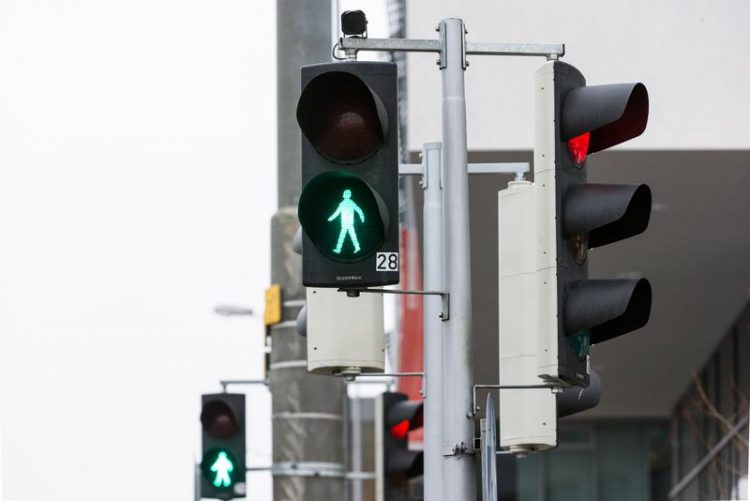New system by TU Graz automatically recognises pedestrians’ intent to cross the road

The innovative pedestrian traffic lights will be in use throughout Vienna from the end of 2020 © Günther Pichler GmbH
In Vienna there are some 200 push-button pedestrian lights (signalised pedestrian crossings). They allow pedestrians to cross the road safely. But only after a waiting time, which is annoying for many people.
This often results in pedestrians not waiting for the green phase, but instead walking in a different direction or crossing the street when the lights are red. For some people, push-button lights are an invitation to trigger off the green phase as they go past – just for fun. Something that annoys car drivers, who have to stop at the crossing even though nobody is crossing the road.
MORE CONVENIENCE – LESS WAITING TIME
In a project commissioned by Municipal Department 33 of the City of Vienna – responsible for urban lighting, traffic lights, clocks and public WiFi nodes – researchers at TU Graz’s Institute of Computer Graphics and Vision have developed a new pedestrian traffic light system in the last three years which is more convenient and meant to replace the push-button system.
The innovative camera-based system recognises the intention of pedestrians to cross the road and switches to green automatically. What’s more, it optimises the traffic flow further, as Horst Possegger from the Institute of Computer Graphics and Vision explains by way of two examples: “The green phase can be extended in the case of large groups of persons, who require more time to cross the road.
And if persons leave the waiting area before the lights have turned to green, this is also passed on to the lights. The traffic lights subsequently don’t switch to green and there are no unnecessary waiting times for motorised traffic.”
CAMERA TRACKING AS BASIS
The main feature is a camera mounted on each pedestrian traffic light. Whereas standard industrial solutions only cover a visual field of two by three metres, this system perceives persons within a field of eight by five metres. It recognises whoever wants to cross the street in seconds.
“It requires one second to estimate the intention – after two seconds the estimation becomes reliable,” explains Possegger. Subsequently, the system signals the wish to cross the road on behalf of one or more persons to the pedestrian light controller. The latter decides when the lights should change – just like a traditional push-button system. “Using the current configurations, our system signals that wish to cross three to four seconds before the button is pushed,” says Possegger.
Horst Possegger knows that this all sounds very simple, but “two years of intensive research were necessary due to the complexity of requirements.” The hardware had to be big enough for a powerful local computer, but at the same time small enough to fit into the switch box of the traffic lights.
Exactness and efficiency was a primary goal of the software. Moreover, the traffic light was also equipped with a monitoring system which can report faults immediately. “This is a double safeguard. The system was developed in such a way that it can work round-the-clock even in a harsh environment and can also deal with voltage fluctuations,” explains Possegger.
Using global movement models and recorded data, the research team developed learning algorithms which recognise pedestrians’ intention to cross the street.
Possegger dispels any worries about data protection. Although the image data are absolutely necessary to detect pedestrians – including children and persons with umbrellas or buggies, the images are only analysed locally and do not leave the camera. The pedestrian traffic light system works exclusively with geometric information from which it derives a possible wish to cross.
IMPLEMENTATION BY THE END OF 2020
The knowledge transfer is currently being carried out from the researchers to Günther Pichler GmbH. The company is responsible for the installation in the Vienna city area and will replace push-button lights with the new camera system at selected locations by the end of 2020 for evaluation purposes.
This research topic is anchored in the Field of Expertise ‘”Information, Communication & Computing“, one of the five strategic research foci at TU Graz.
Read more about the tracking approach in our Planet Research section. The functionality can be seen live in the video “Occlusion Geodesics for Online Multi-Object Tracking”.
Institute of Computer Graphics and Vision
Horst POSSEGGER
Dipl.-Ing. Dr. techn. BSc
TU Graz | Institute of Computer Graphics and Vision
Inffeldgasse 16/II, 8010 Graz
Tel: +43 316 873 5033
E-mail: possegger@icg.tugraz.at
https://vimeo.com/88141421
https://www.tugraz.at/en/tu-graz/services/news-stories/planet-research/singlevie…
Media Contact
All latest news from the category: Information Technology
Here you can find a summary of innovations in the fields of information and data processing and up-to-date developments on IT equipment and hardware.
This area covers topics such as IT services, IT architectures, IT management and telecommunications.
Newest articles

Bringing bio-inspired robots to life
Nebraska researcher Eric Markvicka gets NSF CAREER Award to pursue manufacture of novel materials for soft robotics and stretchable electronics. Engineers are increasingly eager to develop robots that mimic the…

Bella moths use poison to attract mates
Scientists are closer to finding out how. Pyrrolizidine alkaloids are as bitter and toxic as they are hard to pronounce. They’re produced by several different types of plants and are…

AI tool creates ‘synthetic’ images of cells
…for enhanced microscopy analysis. Observing individual cells through microscopes can reveal a range of important cell biological phenomena that frequently play a role in human diseases, but the process of…





















